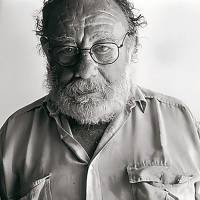(1926-2005)

Follow Paul REBEYROLLE
Paul Rebeyrolle was born on 3 November 1926 in Eymoutiers (Haute-Vienne) and died on 7 February 2005 in Boudreville (Côte-d'Or).
Paul Rebeyrolle's childhood was marked by Pott's disease, a bone tuberculosis that forced him to spend long periods of immobility. He completed his secondary education until he obtained his baccalaureate in philosophy at the Lycée Gay-Lussac in Limoges before moving to Paris in October 1944.
He was a committed member of the Manifeste de l'homme témoin, which, in the aftermath of the Second World War, advocated a return to realism against the trends of contemporary art, around the art critic Jean Bouret. On 21 June 1948, he took part in the "L'homme témoin" exhibition at the Galerie du Bac with Bernard Lorjou, Yvonne Mottet, André Minaux, Michel Thompson, Michel de Gallard and Gaston Sébire. This group of L'homme témoin was to be the founder of the Jeune Peinture movement. In the same year, 1948, he executed a mural fresco for the abattoirs of La Villette, precisely entitled "Les Abattoirs de la Villette".
In 1949, Rebeyrolle initiated the Salon de la Jeune Peinture with Denys Chevalier, Pierre Descargues, Philippe Cara Costea and Gaëtan de Rosnay, whose first edition, entitled Premier Salon des Jeunes Peintres, was held from 26 January to 15 February 1950 at the Galerie des Beaux-Arts.
A member of the French Communist Party from 1953, Rebeyrolle broke with the party in 1956 during the Russian invasion of Hungary and because of the party's duplicity in the face of the Algerian war. On this occasion, he painted a large picture entitled "À bientôt j'espère".
In 1959, he painted Planchemouton (the name of a river and a barn) in Eymoutiers, a large painting commissioned by the committee of the first Paris Biennale, to decorate the staircase of the Palais des Beaux-Arts. In 1963, he left Paris and moved to the countryside to live and work, first in the Aube and then in the Côte-d'Or.
From 1968, he began a cycle of series often defined by the term "political".
His immense work, always figurative, is marked by violence, rage, revolt in the face of oppression or political commitment. It is punctuated by animal and landscape paintings, as well as paintings using materials glued to the canvas (earth, horsehair, scrap metal, etc.). From these amalgams," Jean-Louis Prat perceives, "emerge images that affirm the resurrection of matter, and thus of painting.
Little publicised during his lifetime, unknown to the general public and certain institutions, his work was nevertheless appreciated by the philosophers Jean-Paul Sartre and Michel Foucault, as well as by certain collectors, such as François Pinault. He died on 7 February 2005 in his home in Boudreville. His ashes were scattered in the Planchemouton river in Eymoutiers.

Secure payment
3DSecure 2.2

Free DHL Express delivery from €1,200
Carefully prepared parcel
Parcel tracking

Shipment insured
for the value of the artwork, covering theft and damages

Fairest prices
Certificate of authenticity
Two galleries in Paris
Receive an email as soon as a new artwork is added for this artist
Your message has been sent ! We will get back to you as soon as possible.
Please fill in the form if you need further information such
Please fill in your email address, an email will be sent with a link to update your password.
You can now place orders and track your orders.
To save your wishlist, you can log in or create an account :